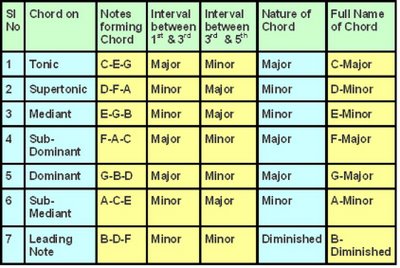As decided earlier we will take C-Major as our example scale for our study.
The triads are formed by the adding of 1st , 3rd, and 5th notes together on any given note.
The notes of C-Major are C-D-E-F-G-A-B-C.
So the 7 triads that can be formed on the notes of C-Major are as follows :
Triad on C – the Tonic ------------------ C-E-G
Triad on D – the Super Tonic ---------- D-F-A
Triad on E – the Mediant --------------- E-G-B
Triad on F – the Sub-Dominant ------- F-A-C
Triad on G – the Dominant ------------- G-B-D
Triad on A – the Sub-Mediant --------- A-C-E
Triad on B – the Leading note --------- B-D-F
Now in order to name these chords, we should know the nature of intervals in between 1st & 3rd as well as 3rd & 5th .
Let us tabulate these intervals and hence the name of Chords derived as follows:

From the above table, we can summarise, for our easy remembering that, in a Major scale,
· the triads (chords of 3 notes) on the Tonic , Sub-Dominant and Dominant are Major Chords;
· the triads on Supertonic, Mediant, Sub-Mediant etc are Minor Chords;
· the triad formed on leading note is a Diminished Chord.
So 3 Major Chords, 3 Minor Chords, 1 Diminished chord are there in any Major Scale.
The above is applicable to any Major scale, be it on Sharps or on Flats…!
For example,
the triad on Dominant of G Major scale will be D - F# - A which is a Major chord…
(….must be major chord as per our generalisation above…!)
Another example, the triad on leading note of E-Major will be D# - F# - A , which is a Diminished Chord
(…yes….must be diminished chord… )
So, remembering the notes sequence of a Major Scale, we can easily write the chords formation and specify the characteristics of such triads based on the location of base note from Tonic.

No comments:
Post a Comment